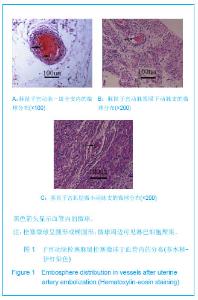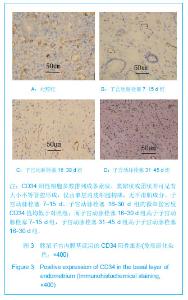| [1] Ravina JH, Herbreteau D, Ciraru-Vigneron N, et al. Arterial embolisation to treat uterine myomata. Lancet. 1995;346 (8976):671-672.
[2] Goodwin SC, Bradley LD, Lipman JC, et al. Uterine artery embolization versus myomectomy: a multicenter comparative study. Fertil Steril. 2006;85(1):14-21.
[3] Narayan A, Lee AS, Kuo GP, et al. Uterine artery embolization versus abdominal myomectomy: a long-term clinical outcome comparison. J Vasc Interv Radiol. 2010;21(7):1011-1017.
[4] Bratby MJ, Walker WJ. Uterine artery embolisation for symptomatic adenomyosis--mid-term results. Eur J Radiol. 2009;70(1):128-132.
[5] Kahn V, Pelage JP, Marret H. Uterine artery embolization for myomas treatment. Presse Med. 2013;42(7-8):1127-1132.
[6] Zhang B, Jiang ZB, Huang MS, et al. Uterine artery embolization combined with methotrexate in the treatment of cesarean scar pregnancy: results of a case series and review of the literature. J Vasc Interv Radiol. 2012;23(12):1582-1588.
[7] Mohan PP, Hamblin MH, Vogelzang RL. Uterine artery embolization and its effect on fertility. J Vasc Interv Radiol. 2013;24(7):925-930.
[8] Lessey BA. The role of the endometrium during embryo implantation. Hum Reprod. 2000;15 Suppl 6:39-50.
[9] Critchley HO, Saunders PT. Hormone receptor dynamics in a receptive human endometrium. Reprod Sci. 2009;16(2): 191-199.
[10] Chien LW, Au HK, Chen PL, et al. Assessment of uterine receptivity by the endometrial-subendometrial blood flow distribution pattern in women undergoing in vitro fertilization-embryo transfer. Fertil Steril. 2002;78(2):245-251.
[11] Lili? V, Tubi?-Pavlovi? A, Radovi?-Janosevi? D, et al. Assessment of endometrial receptivity by color Doppler and ultrasound imaging. Med Pregl. 2007;60(5-6):237-240.
[12] 中华人民共和国科学技术部. 关于善待实验动物的指导性意见. 2006-09-30.
[13] 谭国胜,杨建勇,郭文波,等. 应用三丙烯微球对豚鼠子宫肌瘤模型行子宫动脉栓塞的实验[J]. 中国组织工程研究与临床康复, 2010,14(8):1377-1381.
[14] 何秋明,肖尚杰,夏慧敏.大鼠阴道涂片的观察[J].广州医学院学报, 2007,35(4):54-56.
[15] Weidner N. Intratumor microvessel density as a prognostic factor in cancer. Am J Pathol. 1995;147(1):9-19.
[16] 高英茂.组织学与胚胎学[M].北京:人民卫生出版社,2001: 296-298.
[17] Mercé LT, Barco MJ, Bau S, et al. Are endometrial parameters by three-dimensional ultrasound and power Doppler angiography related to in vitro fertilization/embryo transfer outcome? Fertil Steril. 2008;89(1):111-117.
[18] Matsuda Y, Hagio M, Ishiwata T. Nestin: a novel angiogenesis marker and possible target for tumor angiogenesis. World J Gastroenterol. 2013;19(1):42-48.
[19] da Silva BB, Lopes-Costa PV, dos Santos AR, et al. Comparison of three vascular endothelial markers in the evaluation of microvessel density in breast cancer. Eur J Gynaecol Oncol. 2009;30(3):285-288.
[20] Reiner CS, Roessle M, Thiesler T, et al. Computed tomography perfusion imaging of renal cell carcinoma: systematic comparison with histopathological angiogenic and prognostic markers. Invest Radiol. 2013;48(4):183-191.
[21] Kopczyńska E, Makarewicz R. Endoglin - a marker of vascular endothelial cell proliferation in cancer. Contemp Oncol (Pozn). 2012;16(1):68-71.
[22] Dallas NA, Samuel S, Xia L, et al. Endoglin (CD105): a marker of tumor vasculature and potential target for therapy. Clin Cancer Res. 2008;14(7):1931-1937.
[23] Ziebarth AJ, Nowsheen S, Steg AD, et al. Endoglin (CD105) contributes to platinum resistance and is a target for tumor-specific therapy in epithelial ovarian cancer. Clin Cancer Res. 2013;19(1):170-182.
[24] Lee NY, Golzio C, Gatza CE, et al. Endoglin regulates PI3-kinase/Akt trafficking and signaling to alter endothelial capillary stability during angiogenesis. Mol Biol Cell. 2012; 23(13):2412-2423.
[25] 于建宪,常宏,纪萍.CD105、CD34及Ⅷ因子在不同生理状态下子宫内膜中的表达[J].齐鲁医学杂志,2005,20(3):189-194.
[26] Fan X, Heijnen CJ, van der Kooij MA, et al. The role and regulation of hypoxia-inducible factor-1alpha expression in brain development and neonatal hypoxic-ischemic brain injury. Brain Res Rev. 2009;62(1):99-108.
[27] Schipani E, Maes C, Carmeliet G, et al. Regulation of osteogenesis-angiogenesis coupling by HIFs and VEGF. J Bone Miner Res. 2009;24(8):1347-1353.
[28] Worthington-Kirsch RL, Siskin GP, Hegener P, et al. Comparison of the efficacy of the embolic agents acrylamido polyvinyl alcohol microspheres and tris-acryl gelatin microspheres for uterine artery embolization for leiomyomas: a prospective randomized controlled trial. Cardiovasc Intervent Radiol. 2011;34(3):493-501. |





